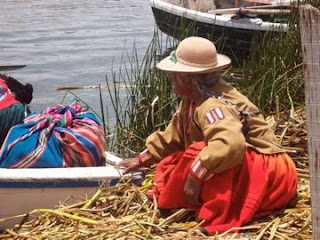These are some pictures from our Thanksgiving dinner that we celebrated at the ProPeru Office. It was a huge event, with every student (there are eight of us) and her entire family, usually including some extended family too. They cooked a turkey, we had mashed potatoes, and then a whole bunch of dishes that were some blend of Peruvian and American - usually including potatoes and rice. It was very delicious, and really good because I was pretty sad to miss the normal celebrations of Thanksgiving in the U.S. It made the day into something new and exciting, and now I treasure the experience of celebrating Thanksgiving in Peru. It made for a weird blend of emotions: Heightened gratitude for the things we enjoy in the U.S. which the rest of the world does not have; a strong sense of unworthiness for being born into that privilege when soooo many other are not; and homesickness. We have SO much to be thankful for.
And I pray that you all had an absolutely wonderful Thanksgiving, full of blessings and relaxing and football and food!
The Kiarita! She is my Peruvian niece, turns 9 months old today, and is quite the bundle of energy. She spends every morning at our house while her Mom works, and for that entire time is doted upon like no other. She is going to be one spoiled child! But oh, is she cute. (Her name is actually Kiara... they just add diminutives onto everything.)

Sleeping Kiara...

This is my Spanish class - Emily, our professor Karina, me, and Allie. A very small class, but we spent so much time with our professor that we got to know her very well. And thanks to her patient and persistent guidance, we have grown leaps and bounds in our language capabilities.

My host Dad, Atilio; and Lauren. Lauren is another international student that works out to be my niece, because she is living with Atilio and Nora's (my host parents) son and daughter-in-law.

I finally got them in one place, feeling dressed up enough for a picture. Left to right, Paula (in the corner) is my host sister who doesn't live at home anymore; she's Lauren's Mom. Then is Tatiana, my host sister who does live at home and runs a dentists office out of our house. She's really cool - she dotes on her nieces like I've never seen, and is a blast to hang out with. She loves volleyball (and is very good at it), so we play together on the weekends sometimes. Then is Carmen, also my niece. Next is Nora, my host Mom - I couldn't have asked for a better temporary mother. She is a sweetheart, and an incredible cook. Then me, then Atilio - my host Dad. He is absolutely hilarious, claims to speak about six languages but really only knows one, spends hours talking to me to improve my spanish, and knows how to say "I want drink beer" and "you are my queen" in english. lol We have fun. :)

All in all, God has blessed me tremendously with this Peruvian family to take me in when I'm so far from my own family. They send you all their greetings quite frequently, and want to know all about you. I wish, sometimes, that all the people I know in all the different little 'worlds' of my life, like Peru, Grand Junction, Fort Collins, and fire could all mix somehow so that I could be with them all at once. But that's asking a lot I guess.
I hope that this holiday season, you are all enjoying spending time with your own families, and counting the many blessings that you have in them. I can't wait to see you all in a little over a week. God bless!
p.s. I realized halfway through the night that my camera was on the wrong setting, which is why most of them are rather blurry. Sorry if you got a headache or something while looking at them! Hopefully I'll have more clear ones later.



































